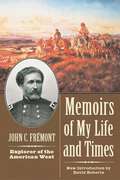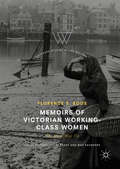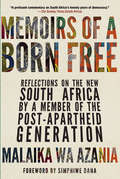- Table View
- List View
Memoirs of My Life and Times
by John Charles FremontDuring his remarkable life, John Charles Frémont served as a senator for the newly-formed state of California, led Union troops in the Civil War, and was governor of the territory of Arizona. His race for the presidency in 1856 brought prestige to the fledgling Republican Party, yet despite his popularity, his uncompromising determination to abolish slavery cost him the election. For all of his experiences in politics and the military, it was the earlier decades of Frémont's life that were the most exciting. Shortly after graduating from college, he joined a mapping expedition and surveyed the hills of South Carolina and Tennessee for the government. Eager to continue exploring, Frémont went on five more expeditions to America west of the Appalachians during the years from 1839 to 1846. He traveled up the Missouri river, crossed the Rocky Mountains, and reached the West Coast on several journeys, often with his friend Kit Carson, the legendary mountain man. In Memoirs of My Life, Frémont recounts those years in the wilderness, encountering the fabulous landscapes and native people of America's interior before the westward expansion of the U. S. His journeys across the unmapped prairies, mountains, and deserts offer a wonderful glimpse of North America's natural grandeur in its original state.
Memoirs of My Life and Writings
by Edward GibbonThe great historian reviews 'the simple transactions of a private and literary life'.
Memoirs of Pancho Villa (Texas Pan American Series)
by Martv?n Luis GuzmánThis is a tale that might be told around a campfire, night after night in the midst of a military campaign. The kinetic and garrulous Pancho Villa talking on and on about battles and men; bursting out with hearty, masculine laughter; weeping unashamed for fallen comrades; casually mentioning his hotheadedness—"one of my violent outbursts"—which sent one, two, or a dozen men before the firing squad; recounting amours; and always, always protesting dedication to the Revolutionary cause and the interests of "the people." Villa saw himself as the champion, eventually almost the sole champion, of the Mexican people. He fought for them, he said, and opponents who called him bandit and murderer were hypocrites. This is his story, his account of how it all began when as a peasant boy of sixteen he shot a rich landowner threatening the honor of his sister. This lone, starved refugee hiding out in the mountains became the scourge of the Mexican Revolution, the leader of thousands of men, and the hero of the masses of the poor. Great battles of the Revolution are described, sometimes as broad sweeps of strategy, sometimes as they developed half hour by half hour. Long, dusty horseback forays and cold nights spent pinned down under enemy fire on a mountainside are made vivid and gripping. The assault on Ciudad Juárez in 1911, the battles of Tierra Blanca, of Torreón, of Zacatecas, of Celaya, all are here, told with a feeling of great immediacy. This volume ends as Villa and Obregón prepare to engage each other in the war between victorious generals into which the Revolution degenerated before it finally ended. Martín Luis Guzmán, eminent historian of Mexico, knew and traveled with Pancho Villa at various times during the Revolution. General Villa offered young Martín Luis a position as his secretary, but he declined. When many years later some of Villa's private papers, records, and what was apparently the beginning of an autobiography came into Guzmán's hands, he was ideally suited to blend all these into an authentic account of the Revolution as Pancho Villa saw it, and of the General's life as known only to Villa himself. The Memoirs were first published in Mexico in 1951, where they were extremely popular; this volume was the first English publication. Virginia H. Taylor, translator in the Spanish Archives of the State of Texas Land Office, has accurately captured in English the flavor of the narrative.
Memoirs of Pancho Villa (Texas Pan American Series)
by Martín Luis Guzmán&“A frequently fascinating and probably fairly accurate insight into the most controversial character of the Mexican Revolution.&” —Time Martín Luis Guzmán, eminent historian of Mexico, knew and traveled with Pancho Villa at various times during the Revolution. When many years later some of Villa&’s private papers, records, and what was apparently the beginning of an autobiography came into Guzmán&’s hands, he was ideally suited to blend all these into an authentic account of the Revolution as Pancho Villa saw it, and of the General&’s life as known only to Villa himself. This is Villa&’s story, his account of how it all began when as a peasant boy of sixteen he shot a rich landowner threatening the honor of his sister. This lone, starved refugee hiding out in the mountains became the scourge of the Mexican Revolution, the leader of thousands of men, and the hero of the masses of the poor. The assault on Ciudad Juárez in 1911, the battles of Tierra Blanca, of Torreón, of Zacatecas, of Celaya, all are here, told with a feeling of great immediacy. This volume ends as Villa and Obregón prepare to engage each other in the war between victorious generals into which the Revolution degenerated before it finally ended. The Memoirs were first published in Mexico in 1951, where they were extremely popular. This volume—translated by Virginia H. Taylor—was the first English publication. &“This biographical history presents as revealing a historical portrait of the Revolution as the author&’s earlier historical novel, The Eagle and the Serpent.&” —The Hispanic American Historical Review
Memoirs of Race, Color, and Belonging (Routledge Auto/Biography Studies)
by Nicole StamantMemoirs of Race, Color, and Belonging provides a fresh look at the complex dialogue of race and identity in memoir, examining three generations of biracial African Americans’ experiences in their autobiographies. Exploring writers from James McBride and Shirlee Taylor Haizlip to Barack Obama, Toi Dericotte, Natasha Trethway, Rebecca Walker, and Emily Raboteau, this volume explores the ways in which these memoirists refute terms regarding race and simple understandings of belonging, using their contested embodied positions as sites for narration, quest, and protest. Organized chronologically, this volume will provide readers insight into memoirs from Jim Crow America to the Civil Rights period and finally those considering the post-soul (and post-Loving v. Virginia) generation. Memoirs of Race, Color, and Belonging interrogates these difficult spaces surrounding identity construction, encouraging new conversations surrounding visibility of mixed-race individuals and experiences for future generations. Through archives and personal testimony, this book provides a model for interweaving theoretical and personal accounts of color in American culture to encourage discussions that transgress disciplinary boundaries in the today’s dialogue.
Memoirs of Victorian Working-Class Women
by Florence S. BoosThis volume is the first to identify a significant body of life narratives by working-class women and to demonstrate their inherent literary significance. Placing each memoir within its generic, historical, and biographical context, this book traces the shifts in such writings over time, examines the circumstances which enabled working-class women authors to publish their life stories, and places these memoirs within a wider autobiographical tradition. Additionally, Memoirs of Victorian Working-Class Women enables readers to appreciate the clear-sightedness, directness, and poignancy of these works.
Memoirs of a Born Free: Reflections on the New South Africa by a Member of the Post-apartheid Generation
by Malaika Wa Azania Simphiwe DanaApartheid isn't over—so Malaika Wa Azania boldly argues in Memoirs of a Born Free, her account of growing up black in modern-day South Africa. Malaika was born in late 1991, as the white minority government was on its way out, making her a "Born Free"—the name given to the generation born after the end of apartheid. But Malaika's experience with institutionalized racism offers a view of South Africa that contradicts the implied racial liberation of the so-called Rainbow Nation. Recounting her upbringing in a black township racked by poverty and disease, the death of a beloved uncle at the hands of white police, and her alienation at multiracial schools, she evokes a country still held in thrall by de facto apartheid. She takes us through her anger and disillusionment with the myth of black liberation to the birth and development of her dedication to the black consciousness movement, which continues to be a guiding force in her life. A trenchant, audacious, and ultimately hopeful narrative, Memoirs of a Born Free introduces an important new voice in South African—and, indeed, global—activism.
Memoirs of a Buccaneer: Dampier's New Voyage Round the World, 1697
by William DampierIt was William Dampier's passion to see the world that turned him into a buccaneer. He possessed remarkable powers of observation and analysis, and his life as a seventeenth-century navigator aboard pirate and privateering ships is brilliantly detailed in his journal. Throughout his travels of Central and South America and the East Indies, Dampier provides riveting accounts of sea battles against Spanish treasure ships, as well as pirate life, lore, and customs. Originally published in 1697 as the New Voyage, his journal became an instant success, and has been read ever since as one of the greatest travel and adventure accounts ever written.But Memoirs of a Buccaneer is far more than historical adventure. Dampier was a man of intelligence and education with a strong naturalist's urge, and his book quickly became a vital source of information on the geology, biology, zoology, and peoples of the lands he visited. His descriptions of the West Indian manatee, booby birds, cacao, and mangrove trees--flora and fauna never before heard of in England and the Continent--are incredibly accurate. His notes on the produce of Guam and Mindanao--coconuts, vanilla beans, bananas, breadfruit, and more--exerted a powerful influence on Britain's explorations and colonizations. And his depictions of Central America's Mosquito Indians and the natives of Mindanao proved to be highly reliable.The influence of this classic book on the work of later travelers is incalculable, leading writers such as Defoe, Swift, and Coleridge to borrow both facts and literary style from it. It continues to inspire readers today.
Memoirs of a Child Holocaust Survivor: Living Without Hatred
by A.M. FoxA.M. Fox&’s testament to her late husband&’s bravery brings home the horrors of life in the camps without ever resorting to sensationalism. Utterly free from self-indulgence, this clear-sighted memoir is all about Harry as an individual, his quiet courage and resilience, and the remarkable and defiant personality that enabled him not only to survive but to flourish in later life. I found parts of the book horrifying beyond words but was inspired by the positivity that shone through in spite of everything.&’ — Catherine Coldstream, author of &‘Cloistered: my Years as a Nun&’A Holocaust survivor recounts his memories from pre-war Poland to liberation, honouring lost family and culture.These are the memories of a man who had been a young Jewish boy in Central Poland. His ninth birthday came in mid-July 1939. Less than two months later, they are his memories of the Nazi era, from the very beginning of WW11 until he was liberated by the Russians on the 8 May 1945. This age of death, when the Nazis attempted the absolute annihilation of all Jews in Europe regardless of age, character, or gender, is now referred to as the Holocaust.These memories include those of his vibrant family life in Poland before the war. They are his homage and his memorial to his parents, his little sister and numerous uncles, aunts and cousins who were wiped out by the Nazis along with centuries of their culture.Arriving in the UK on 14 August 1945 he was in the first group of Concentration Camp child survivors brought into England at the invitation of King George V1. The story of these children&’s arrival and initial rehabilitation in the Lake District is also told in the 2020 BBC film: The Windermere Children.His memories conclude with some glimpses of his life immediately after liberation, and later when he made his home in the UK.From dozens of known relatives living in their town when war began, he and his elder brother thought for a long time that they were the only two survivors. Later they discovered there was a third survivor, an even younger cousin.All the material concerning life in Poland, life during the war and vignettes of post war life were checked by the survivor as being true to what he remembered. He also wanted to include something about how the author, his second wife, came to meet him, and this tale begins the book.&‘This memoire is a resounding affirmation of life in the face of the barbaric culture of death of the Holocaust. Harry&’s courage and humanity rings out. Without food and friendship, no one could survive. May we never forget, lest such atrocities happen again!&’ — Cardinal Timothy Radcliffe&‘I was once giving a talk alongside three professors to five hundred graduates and undergraduates. The professors each tried to explore &“why&” the Holocaust happened. I had to set them straight – there is NO &“why.&”&’ — Harry Fox&‘Unique in its scope – revealing the world lost, the horror survived, and what came next … An emotive and beautifully written read – heart-wrenching, and full of hope in equal measure.&’ — Big Sky Review &‘We must each say NO to hatred.&’ — A.M. Fox"An emotive and beautifully written read—horrifying, heart-wrenching, and full of hope in equal measure."







